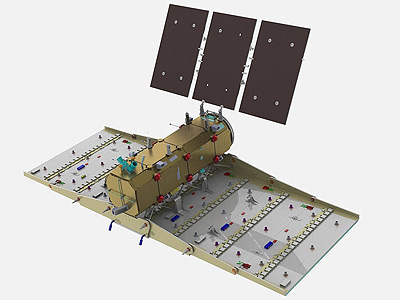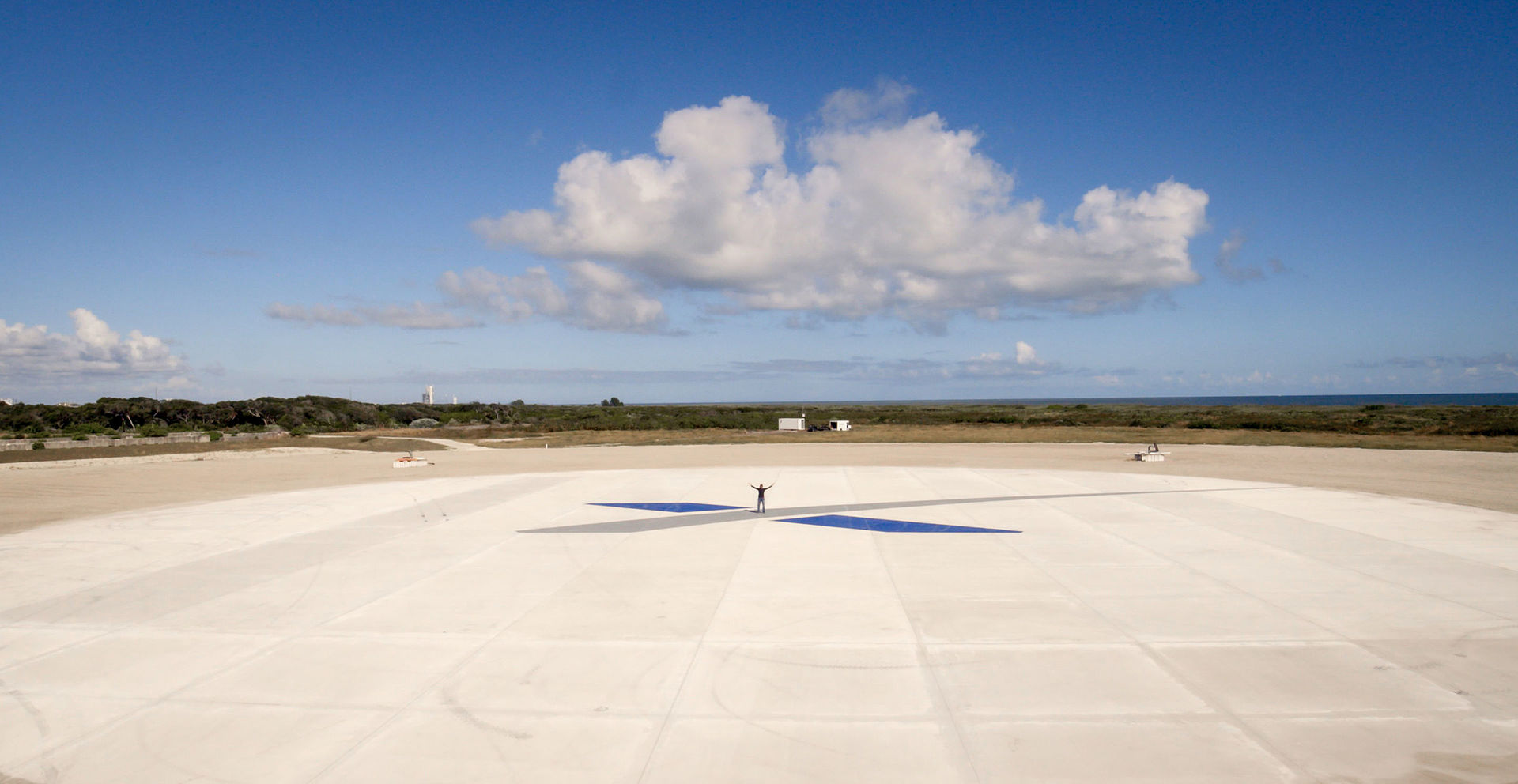If there’s one thing we’re starting to get used to, it’s the spectacular landings by SpaceX. These were typically done at three distinct locations: on land at Cape Canaveral, in the Atlantic on the OCISLY barge, or in the Pacific on the JRTI barge. However, with its launch on October 8, 2018, SpaceX inaugurated a new landing site: LZ-4 at Vandenberg, on the west coast of the United States. This third ground landing zone will allow the American company to recover its boosters more quickly after their flights, even for launches into polar or heliosynchronous orbit, as was the case for SAOCOM 1A on this day.

A bit of history
Acronym for Satélite Argentino de Observación COn Microondas (Argentinian Microwave Observation Satellite), SAOCOM comprises two Earth observation satellites. They were developed by the Argentine space agency (CONAE) and manufactured by the Argentine company INVAP, specialized in advanced technologies (nuclear energy, aerospace, radars, etc). This project was initiated in 1998 to provide information about soils, water, and vegetation.
In June 2002, a first conceptual review was conducted with the participation of CONAE, INVAP, NASA, the Brazilian Space Agency (AEB), and CNES. At that time, the launch was planned for 2004, a date that was constantly postponed due to budgetary and technical reasons, given the complexity of the satellite. Six years later, in October 2008, a second conceptual review was successfully conducted. In the same year, CONAE received funding from the Inter-American Development Bank to carry out its SAOCOM project.

It wasn’t until April 16, 2009, that the Argentine space agency signed a contract with SpaceX to launch its two SAOCOM 1A and 1B satellites into orbit using two Falcon 9 rockets. In 2012, we finally witnessed the first concrete tests, including tests of the thermal regulation systems. These tests proved to be functioning as expected, and further tests were conducted in 2014 on the thermal covers.
In October 2017, the structure of the satellite was finally completed, and initial environmental tests began. By December of the same year, all functional elements had been integrated into the satellite, and SAOCOM 1A was ready for its flight! A final review was conducted from May 7 to May 11, 2018, to ensure that all systems would be operational once in orbit. On July 15, the radar antenna, which will be used by the satellite to perform all its scientific measurements once in space, was closed for the last time before its launch, thus concluding all tests.

On July 30, 2018, an Antonov An-124 cargo aircraft landed in Argentina to transport SAOCOM 1A. It took off again on August 1 before arriving at Vandenberg Air Force Base the following day. A week later, the launch was announced, and the integration of the satellite into the Falcon 9 fairing could begin for a launch scheduled in October.
A few technical points
SAOCOM 1A measures 4.5 meters in height with a diameter of 2.9 meters when the solar panels and radar antenna are folded. The satellite platform (its structure) is derived from another Argentine satellite: SAC-C, which remained in orbit from 2000 to 2013. SAOCOM 1A weighs approximately 3000 kg at liftoff and has a lifespan of 5 years in orbit.

This satellite is powered by a large solar panel measuring 15 square meters, which is deployed in orbit. This panel was developed and manufactured at the engineering faculty of the National University of La Plata. On the other hand, the entire thermal regulation system was provided by the Teófilo Tabanera Space Center, a complex of CONAE. SAOCOM 1A uses two types of communication: S-band for telemetry and various commands, and X-band for transmitting data acquired by the radar. This download occurs at approximately 40 MB/s, while the satellite has a memory of 32 GB.

SAOCOM 1A’s main tool is an SAR radar for Synthetic Aperture Radar. This was developed by the Argentine Institute of Radio Astronomy. It measures 10 meters long and 3.5 meters wide and is composed of nearly 140 small radar antennas, which allow it to create a relatively precise 3D model of our planet. To achieve this, the radar successively “illuminates” the surface with microwaves (L-band) and then captures their echo to associate an altitude with each point in its field of view. Since the satellite is in motion, the same point will be illuminated multiple times, which increases the precision of the measured and calculated data. Thanks to this system and very powerful mathematical functions (including Fourier transform), it is then possible to recreate a three-dimensional model of various parts of the surface or even the entire globe. A huge advantage of radars is that the emitted waves pass through clouds with minimal disturbance. Thus, it is easily possible to map geographical areas even if the climate does not seem conducive to it.
A project related to Italy
Since 1992, CONAE and the Italian Space Agency (ASI) have collaborated on the SAC-B and SAC-C projects, two other Argentine satellites. While CONAE worked on its two SAOCOM 1 satellites, ASI began developing its Cosmo-SkyMed constellation, which has very similar characteristics to the two Argentine satellites. The very good relations between the space agencies of the two countries led to the creation of the SIASGE project (Sistema Italo Argentino de Satélites para la Gestion de Emergencias or Italian-Argentine System of Satellites for Emergency Management) in July 2005. Thanks to this project, the sharing of data obtained by Argentine and Italian satellites is facilitated and formalized. This cross-referencing of information will provide very precise alerts for fires, floods, avalanches, and other natural disasters.

The SIASGE has a direct influence on the orbits of the satellites because the six satellites involved (2 SAOCOM 1 and 4 Cosmo-SkyMed) are placed in heliosynchronous orbits at the same altitude (620km) but on six different planes to provide updates every 12 hours of the same point on the surface. This greatly facilitates the monitoring of disasters.
In May 2016, CONAE and ASI signed a letter of intent encouraging them to launch a second version of this project: SIASGE II. The aim is to intensify and strengthen cooperation in the fields of science, research, and space techniques for peaceful purposes, particularly in the prevention and management of emergency situations.
First RTLS on the West Coast
SpaceX currently has two launch sites: two launch complexes on the East Coast of the United States (LC-39A and SLC 40) and one launch site on the West Coast (SLC-4). However, it turns out that the SLC-4 launch area is actually composed of two launch pads: SLC-4E and SLC-4W. SpaceX has decided to retain SLC-4E as the launch site for its Falcon 9 rockets intended to orbit satellites in polar or near-polar orbits, and to convert SLC-4W into a landing zone. While SpaceX already had two Landing Zones at Cape Canaveral on the East Coast (LZ-1 and LZ-2), the company did not have any at Vandenberg on the West Coast, thus it was forced to always land its boosters on the JRTI barge hundreds of kilometers away in the Pacific Ocean. This option is convenient in that the booster does not need to perform a long boostback burn to return close to its launch pad, but on the other hand, this procedure does not allow for a quick return of the booster, which typically takes several days to return to port.

That’s why SpaceX decided to build a third landing zone at Vandenberg: LZ-4. This will allow boosters to perform the procedure known as RTLS for Return To Launch Site. However, this procedure was not invented by SpaceX. It actually existed during the era of the space shuttles and was considered a very critical emergency. If a problem with the launcher was detected shortly after liftoff and it was too severe (such as the loss of an engine) to continue to orbit and return after one revolution (Abort To Orbit or ATO), it was possible, once the solid rocket boosters were jettisoned, to turn around with the external tank and remaining RS-25 engines to consume all the fuel (from the external tank and the shuttle) to lighten the orbiter. The orbiter would then separate from the tank and perform a landing on the massive runway at the Kennedy Space Center. This type of mission abort was never executed and was considered extremely dangerous after several astronaut training simulations. It’s important to note that even the RTLS would not have saved Challenger because the problem that led to the loss of the crew and vehicle occurred before booster separation.

As for SpaceX, the RTLS is not an emergency maneuver but rather a maneuver allowing the Falcon 9 booster to return more quickly to the launch pad, thus enabling it to be re-prepared more rapidly for a future launch. SAOCOM 1A represents an excellent target for testing this LZ-4 because, with its mass of only 3000kg, it remains well below the Falcon 9’s limits, ensuring that the booster’s tanks will still be sufficiently filled at the time of stage separation. Additionally, the booster used for this flight is not on its first launch; it is the B1048.2, which previously orbited ten Iridium NEXT satellites during the Iridium NEXT VII mission under the name B1048.1.

An essential point to note is that a landing performed by SpaceX involves an object traveling at supersonic speeds, causing sonic booms. There are three sonic booms in total, generated first by the engines, then by the landing legs, and finally by the grid fins, as illustrated in this video during the Falcon Heavy launch at 6:47 (ten booms are heard because there were two boosters and an echo due to the buildings). At Cape Canaveral, these booms do not pose significant issues because the base is so large that there are no residences within several tens of kilometers. However, Vandenberg Air Force Base is much smaller, and some people living near the base could clearly hear these supersonic booms!



